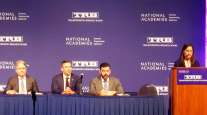E&MU: SmartWay Program May Help EPA Shape Greenhouse-Gas Rules
This story appears in the July/August 2012 issue of Equipment & Maintenance Update, a supplement to the July 9 print edition of Transport Topics. Click here to subscribe today.
As federal regulators ready mandates to curtail greenhouse-gas emissions and improve heavy-duty trucks’ fuel mileage, Environmental Protection Agency and trucking company officials said that research gleaned from EPA’s 8-year-old SmartWay program can help shape those rules.
The new regulations, being developed by EPA and the National Highway Traffic Safety Administration, set different targets for various truck sizes and applications, with voluntary targets beginning in 2014 and mandatory fuel-use cuts of 20% by 2017. The agencies have said they also will mandate trailer efficiencies in future rules.
“Going forward, SmartWay will continue to serve as an important program for new and emerging technologies and strategies,” an EPA spokeswoman told Equipment & Maintenance Update.
Some motor carriers, however, worry that the forthcoming mandates could mean SmartWay’s role will diminish.
“That kind of mandating of OEMs [through the new regulations] takes a lot away from SmartWay,” said Randy Mullett, vice president of government relations and public affairs for Con-way Inc., Ann Arbor, Mich. “Once fuel economy and trailer manufacturing standards take effect, that becomes the new price of entry. I think SmartWay can help differentiate between those [carriers] that have gone above and beyond because the equipment is a small portion of sustainability.”
Launched with great fanfare in 2004, the SmartWay Transport Partnership has attracted 2,900 industry partners. To participate, carriers submit company and operational data, such as fleet type, class and age, fuel use, idle times, number of miles traveled and payload, to the EPA. They are then ranked into five performance areas, and the top-performing carriers earn the right to use the SmartWay partnership mark that denotes superior performance across their operations. EPA also has a SmartWay logo for use on vehicle models that exceed emissions and fuel use criteria.
EPA and some motor carriers said the program has helped the trucking industry achieve significant fuel savings and reductions in emissions. But both sides agree that more can be done, and some fleets already are exploring how new methods for measuring environmental efficiency might advance the program as planned adoption of the greenhouse gas rules draws nearer.
For example, driver training and route optimization may take on more importance, Mullett said, adding that Con-way, which ranks No. 3 on the Transport Topics Top 100 list of the largest for-hire carriers in the United States and Canada, is beginning to focus on technology to bolster its sustainability efforts. The fleet is rolling out route optimization and navigation systems to help improve fuel mileage.
“Most fleets are getting 6 miles per gallon. If you can save 10% of your miles, all of a sudden you’re getting 6.6 miles per gallon. It is hard to get that type of savings on the truck,” Mullett said.
The carrier also has switched to wide tires in its truckload fleet, installed aerodynamic devices for trailers on a third of the fleet and installed idle-reduction technology on every unit. Since joining SmartWay in 2005, Con-way said it has saved more than 6 million gallons of fuel a year just from limiting the speed the trucks travel.
Penske Logistics, Reading, Pa., which ranks No. 9 on the for-hire TT 100, said it has seen a 24% reduction in CO2 emissions on a grams-per-mile basis and a 16% reduction in idle hours per truck per year. These results were achieved by cutting maximum truck speeds to 63 mph from 65 mph, investing in route-optimization software and requiring driver training on progressive shifting techniques. In addition, Penske said about 75% of fleets it contracts to haul freight are SmartWay partners.
Penske also has invested in reporting tools that provide greater visibility into vehicle and driver performance.
“For shippers’ performance to improve, they need to utilize SmartWay partners to move their freight. The more partners you use, the better your score is going to be,” said Drew Cullen, vice president of energy and telecommunication services for Penske Truck Leasing, which also is based in Reading. “The benefits are there. They’re tangible. We see them, and our customers see them,” he said of the program, which his company joined in 2009.
In fact, carriers said they plan to continue participating in SmartWay as long as they keep realizing a return on the investment.
“I like to say I’m green and the customers love it, but we’re money driven,” said Royal Jones, chief executive officer of Mesilla Valley Transportation, Las Cruces, N.M. Jones said his company focuses on driver behavior to improve fuel efficiency.
While Mesilla Valley does invest in equipment to improve fuel mileage — including battery-powered auxiliary power units, wide tires, trailer skirts and boat tails (devices that help get rid of negative air, or drag, on the back of the trailer) — he found that, without driver buy-in, the equipment couldn’t reach its potential.
To encourage drivers, Jones gives away $25,000 a year and a motorcycle every three months for those drivers who reach a certain fuel mileage target and have zero accidents and a 98% on-time rating.
“You create a culture of caring about sustainability,” he said, adding that he has saved 5 million gallons of fuel a year since the company, which ranks No. 66 on the for-hire TT 100, joined SmartWay in 2008.
“I still believe that it is the fuel savings, the cost savings and the regulatory drivers that are determining the end decisions” said Nanci Tellam, group director of environmental services for Ryder System Inc., which ranks No. 12 on the for-hire TT 100. “Having said that, there are customers who say, ‘I am servicing a green company or a university, and they are asking me if I’m a SmartWay carrier.’ ”
Indeed, while the program is voluntary, many carriers find joining SmartWay is necessary because of customer demand.
“We’ve seen a number of inquiries from customers wanting to know our score and our grams per mile of NOx,” said David Graham, vice president of maintenance for Paschall Truck Lines, Murray, Ky.,which joined SmartWay five years ago. While Paschall, which ranks No. 87 on the for-hire TT 100, was committed already to sustainability, being part of SmartWay “helped us cost-justify some of the technology we weren’t doing.”
To increase its fuel savings, Paschall utilizes fuel-efficient tires, side skirts and aluminum wheels on its tractors. All of Paschall’s tractors are equipped with auxiliary power units, and the fleet’s idle percentage is down to 2% to 3 % from 4% to 5% five years ago, he said.
SmartWay started with 15 shippers and carriers, along with American Trucking Associations and Business for Social Responsibility. The goals of the program were — and still are — to increase the use of fuel-efficiency technologies and strategies that lower emissions and reduce the trucking industry’s environmental effects. To date, SmartWay partners have achieved reductions of 23.6 million metric tons of carbon dioxide (CO2), 235,000 tons of nitrogen oxides (NOx) and 9,000 tons of particulate matter, while saving 2.3 billion gallons of fuel and $6.8 billion in fuel costs, an EPA spokeswoman told E&MU.
“It speaks volumes about what a voluntary standard can do,” Tellam said. Ryder has three partnerships with SmartWay — affiliate, logistics and carrier. According to a 2010 report by Ryder, partner carriers accounted for 92% of all of the freight miles carried and 77% of the freight managed by the company’s logistics division. Only 29% of all of Ryder’s carriers were not reported by EPA to be SmartWay certified.
“That is intentional,” said Tellam, indicating that Ryder did a disproportionate amount of work with SmartWay partners because of their status with the program.
Other trucking executives agreed that teamwork has and will continue to be vital to the success of the SmartWay program, however it evolves. In Penske’s case, Cullen said, that means working with customers to help them look at asset management and driver education as ways to achieve their SmartWay goals.
Paschall’s Graham added, “You get the low-hanging fruit first. We set targets . . . we want to meet through new technologies and updating the fleet. As we get into trailer technologies, we’ll continue to reduce emissions.”
He noted that carriers can use a wide variety of techniques and devices to meet their SmartWay objectives, and technology and equipment providers can become SmartWay partners as well. That list helps carriers when deciding where to invest, he said. “SmartWay provides a clearinghouse of technologies that helps you know where to look,” he said.




